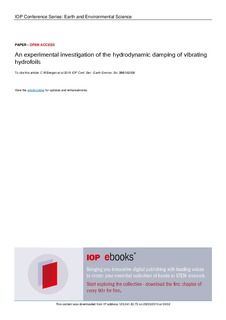| dc.description.abstract | As Francis turbines are chasing a higher efficiency, while trying to accommodate a wider load region, turbine blade fatigue is becoming a more pronounced problem. Details of the Fluid-Structure Interaction (FSI) between the turbine blades and the passing water is necessary to accurately predict the dynamic behavior of a runner in the design phase. The dynamic behavior of the turbine blades is characterized by three properties: The added mass of the surrounding water, the increased stiffness due to passing water, and the hydrodynamic damping provided by the surrounding water. Of the aforementioned properties, the hydrodynamic damping is not yet fully understood. When the turbine blades are excited close to resonance, the damping of the vibrating system determines the vibrational amplitude, and is therefore important in order to estimate the lifetime of a runner. The hydrodynamic damping of passing water has been investigated in a simplified setup, where the turbine blades are represented by a 2D hydrofoil. Two separate hydrofoil geometries have been tested. The hydrofoils were mounted in a "fixed-beam" configuration, meaning that both the deflection and the angle at the fastening point is zero. This setup was chosen, since it is the way that turbine blades are fastened in a Francis runner, and should therefore give applicable results when performing modal testing. The hydrofoils were mounted without any angle of attack, and exposed to water velocities up to 28 m/s. Modal tests in the entire velocity regime indicates that the damping factor increases linearly with water velocity, but at different rates below an above lock-in. The damping factor is rapidly increasing when the velocity goes beyond that of lock-in. This behavior is observed for both hydrofoils, even if the magnitude of the vortex shedding is of different magnitude for the two. A slight increase in natural frequency was also observed with increasing velocity, due to a combination of a stiffening effect of the water passing over the deflected blade, and a reduced added mass effect, in that the amount of water that vibrates with the hydrofoil is diminished when the water velocity is sufficiently high, i.e. it is blown away. The measurements have been compared with CFD simulations, indicating that the observed trend does indeed continue up to at least 45 m/s, indicating that the results are applicable to the velocity regimes occurring in a prototype Francis runner | nb_NO |

